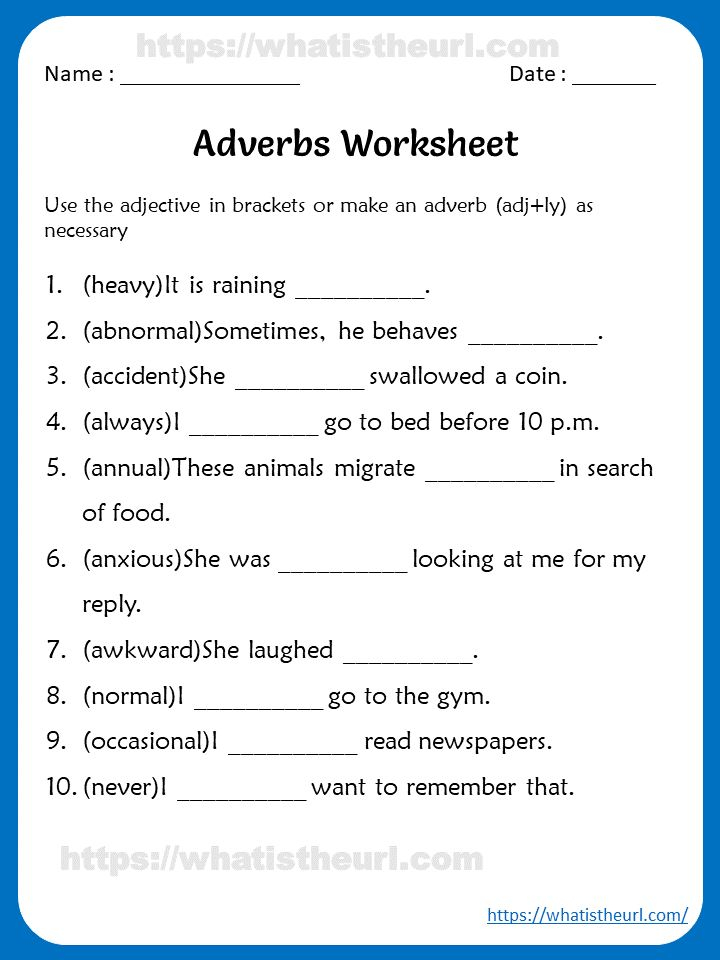Adverbs Worksheet Year 3 – A verb is described as an adverb. Adverbs are used for indicating when, where and how an action was carried out. They are often placed before the verb, adjective or adjective they modify.
Here are a few examples.
He ran quickly.
She sang wonderfully.
They are fluent in English.
There are numerous possibilities to make adjectives. There are multiple ways to create adverbs. It is possible to create additional adverbs by mixing words.
He drives slowly.
He arrived on-time.
Adverbs are usually placed at the beginning or the end of an expression. The intention behind the adjective will determine the place it is placed.
It is evident that, adverbs that modify verbs must be placed after the verb. Adverbs that modify adjectives and other adverbs should be put before the adjective or another adverb they are modifying.
For an example:
He is a slow-moving motorist. (incorrect)
He’s a driver who’s slow. (correct)
He drives slowly. (correct)
They showed up promptly. (correct)
They arrived quickly. (incorrect)
Let’s discuss the adverbs. These worksheets will enable students to learn how to use Adverbs in sentences. The worksheets are divided into three parts that focus on identifying adverbs, and then forming them.
It is necessary to examine various sentences and identify the proper adjectives. The first part focuses on the identification of Adverbs. The next section, Adverbs: Practice, will show you how to utilize adverbs as adjectives and verbs. The third section, forming Adverbs will help you learn how to convert adjectives into adverbs.
What are you putting off? These adverb worksheets are easy to utilize. Grab the pencil.
Adverb Worksheets – Types and Uses
An adverb is an adjective that is a verb or a different word. Adverbs let you know what time, place the event occurred, and also how it happened. Adverbs, for instance, are usually placed following a verb.
Slowly, he walked through the room.
The majority of adjectives can be created by adding -ly to adjectives.
Adjective slow
Adverb: slowly
Adjective: quick
Adverb: quickly
Adjective: hard
Adverb: Hard
An adverb is either a multi-word or one-word adverb. For instance, a one-word adjective is the -ly version.
He was slow to move around the room.
Multi-word adverbs are made up of many words such as:
He walked slowly through the room.
These are some multi-word adverbs which are used frequently:
adverb + adverb: quite slowly, extremely quickly
Adverb + adjective: Very hot, very chilly
Preposition + adverb: without delay, ahead
There’s two types of adjectives.
1. Adverbs to describe ways
The adverbs of fashion tell us how something is accomplished. Consider this:
Slowly, he moved through the room.
This sentence shows slowly his movements.
These are only two examples of adverbs to describe the way in which things happen.
Slowly, rapidly, slowly noisy, loudly and slowly
2. Adverbs that refer to places
Place adverbs indicate where something has been accomplished. Let’s take this example as an example:
He moved about the room.
The adverb that is at the end of this sentence indicates the direction the person has walked.
These are just two examples of place adverbs.
Outside up and down, and nowhere else
Additionally, there are adjectives that describe frequency and time. Adverbs that express the time of an event, for example “when something was done” are also available.
Slowly, he walked through the room.
The sentence is using slow as an adverb.
Adverb Worksheets-Tips and tricks
Adverbs can be words that modify the meaning of a verb or adjective. These worksheets are designed to teach students the many applications of Adverbs. These are some tips and tips that will help you get the best from your worksheets on adverbs.
1. There are a myriad of sentences.
Adverbs are used in many different types of sentences. Make it interesting with your worksheets. You can incorporate simple sentences and complex sentences. This will allow your students to understand the different uses of adverbs.
2. Utilize the adverbs for emphasis.
When you are creating worksheets for students, make sure you note the adverbs you use in every sentence. This helps your students to spot them. Each sentence could be represented using a different hue.
3. Let your students make their own sentences.
Students should be able to complete worksheets with blanks but also create sentences using adjectives. They will be able understand how adverbs are used in writing.
FAQs on Adverb Worksheets
1. What are adverbs? And how do they function?
An adverb describes an adjective verb, adjective, or another word. Adverbs define the time, place, or the way something was carried out. These often end with the -ly
2. What are the most used adverbs?
There are four kinds of adverbs.
3. Are there any examples of adverbs that I can use in my writing
Adverbs can be used as adjectives, or as verbs. Adverbs help create writing that is more engaging and descriptive.
4. What are some popular expressions that you can use to describe adjectival terms?
Common adverbs: quickly and slowly; slow, well; soft and hard, early and later; never, ever; occasionally, but frequently.





